How is ICT taught at school in a village with no electricity?
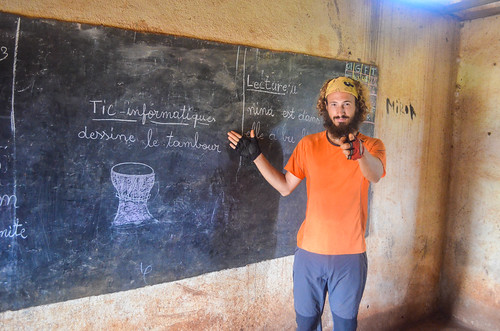
All the villages of the Bamoun region are Muslim. The dirt road starting from Foumbot and heading south is part of the Foumban sultanate. No more than 50 kilometers westwards runs parallel the asphalted main national road, via Bafoussam, Bangangte and Tonga. In between, the Noun river separates the two worlds.
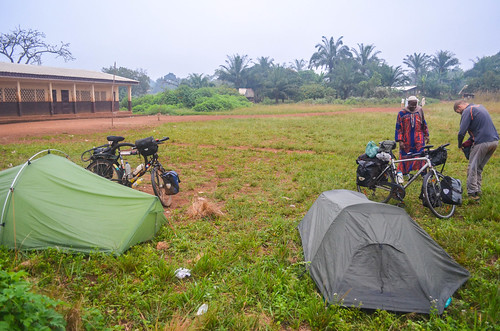
I leave the Nkoutoulanden school grounds with deflated tires. It is intriguing that my two tires are almost flat. Did a kid do that during the night? Improbable. Was it already under-inflated and I didn’t notice it? It happens. Did I have two small punctures yesterday? It never happens with the Schwalbe tires and it would be really bad luck. I inflate the tires and it seems to hold together … let’s ride.

In the world we cycle, there is no electricity, no water (there are no manual pumps as everywhere else in the center of the villages), no decent road allowing traffic (there is only 1 car-taxi passing in a day), and very rarely phone network. Phone network works like “yes, just go 11 km further on this road and you’ll get network“.

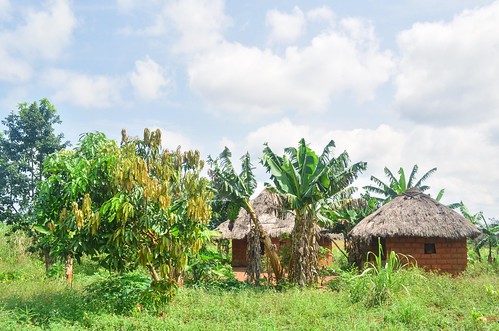
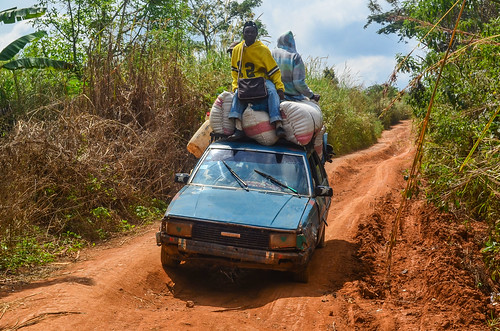
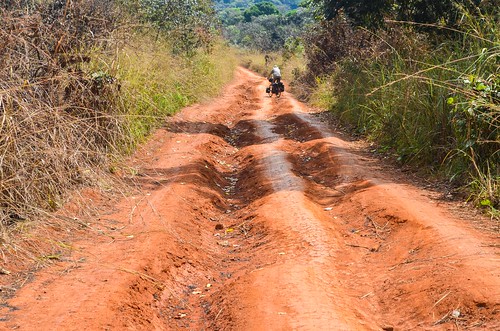
This part of the country looks really abandoned, forgotten by the government, considering it is not especially remote or hilly. Some villagers we talk to ask us to report the situation “when you reach Yaoundé“, thinking White people can resolve a situation better than locals, even though we are just cyclists trying to make it through the Bamoun.
We have deliberately chosen this road to avoid the traffic on the main one, knowing we would handle somehow the roughness. If a car can drive through it until the next tar road, so can we. But we barely manage to complete 50 kilometers per day.
It is also a mystery, or could it be extreme selfishness, that many of the African political leaders can accumulate an incredible wealth without even bothering to give to their population tar roads, electricity and water. The resources of the countries, in most cases, seem huge enough to “allow” the presidents to make billions while building small power plants and roads for everyone. But it just doesn’t happens. It even seems to produce a negative result when black gold is discovered. The population suffers more of this “resource curse” while the president can’t remember how many mansions in the US, castles in France and bank accounts in Switzerland he owns.
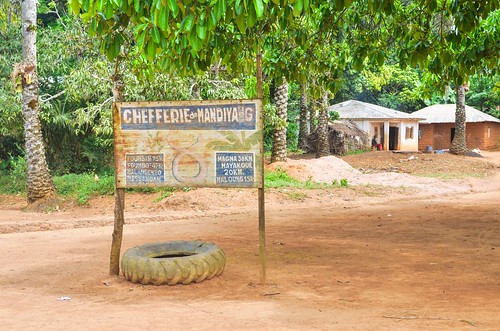

I notice many whiskey sachets on the floor. They are the cheapest way to get drunk, from 50 CFA (0.1 €), and are sold almost everywhere. The villagers ensure me that it’s the fault of the few Christians living in the region … that would make a huge amount of alcohol sachet trash per Christian!
The road in the bush is really bad. The question is “how long ago did the grading machine visit this area?”. Every villager has a different answer, but for sure it is many years ago. We notice one or two rusty road rollers buried in the growing vegetation on the roadside.
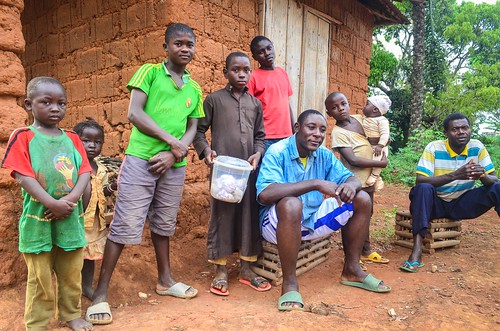
Some of the Muslims of this area have really different facial features. I cannot explain the difference, but they look different from all the Cameroonians I have seen.
Since the main concern with cycling on those remote roads is cleared (it was: “Is there really an exit? Isn’t the road cut at some point?”), the major worry becomes “When and where will we find food”. And it smells like plum pie all over the savanna. It is really unfair. The burnt grass diffuses this sweet perfume all over.
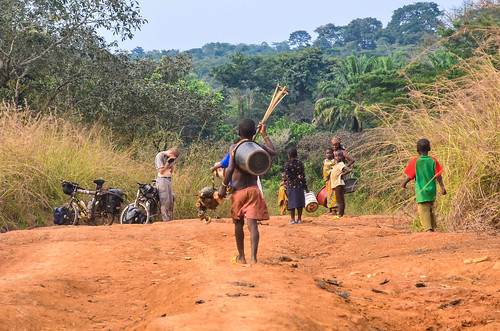
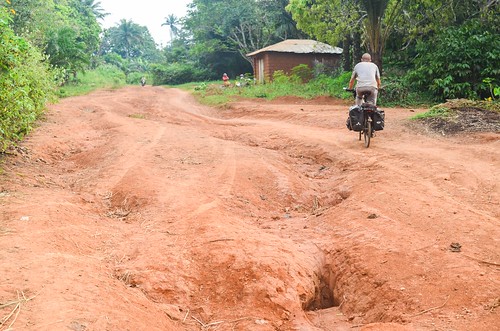
In the late afternoon, in Mayakoué, my tire is flat again. It happens right in the middle of the village. It means I have to patch it under the curious observation of many of them, just gathering around me to be watching without saying a word. I really don’t need to have silent men and kids in my back. Or worse, they can be watching and awkwardly helpful, commenting the obvious, like “the tire is still flat“. The inner tube, manufactured by Kenda, appears to be dead: the rubber at the base of valve is open. I need to switch to a spare tube. Flat in the morning, it is actually already good that it held the air the whole day.
When I ask Cyril to take a picture, hoping the sight of the camera will disperse the watchers (it happens often), it actually produces the opposite result I expected: they now gather proudly behind me to take a pose (sigh ….).
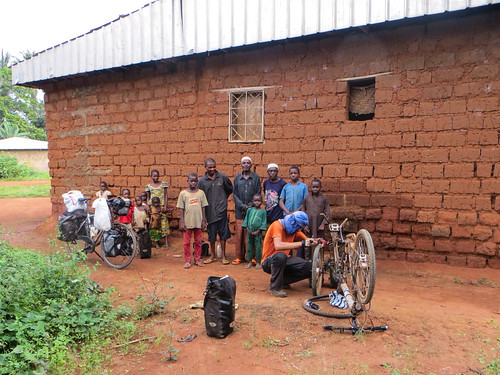
In the meantime, Cyril notices he has a broken spoke. While he replaces it, I realize that my new tube won’t inflate: it is punctured already. Grrrr …. And by the time I put on a third one, it is night already.
Finally, one of the villagers asks us not to leave Mayakoué at night and offers a room in his house. Hospitality is never down. So we will shower with half a bucket of cold water for two, just in front of the house of Papa Njansié Adamou. One advantage of the bucket shower and the non-electrified villages is that one can shower really anywhere.
We want to leave Mayakoué for the tar road today. There is approximately 60 kilometers, on the bad dirt road, and it should be possible. We say goodbye to our hosts after a short visit of the village.
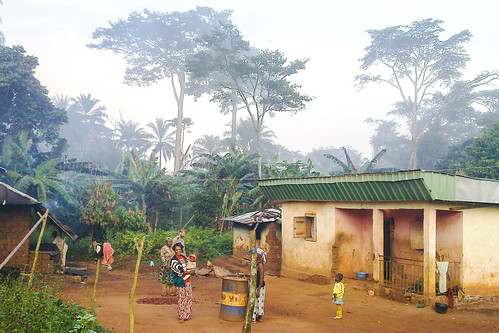
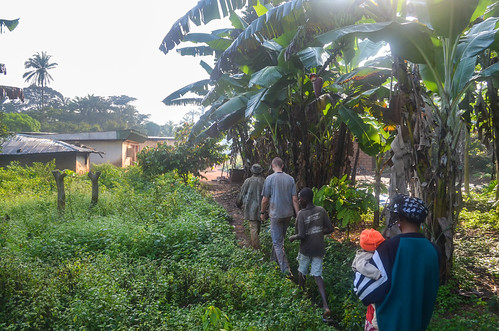
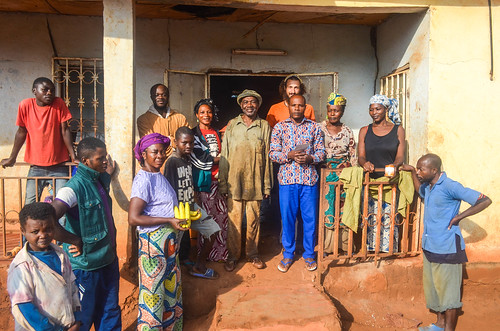
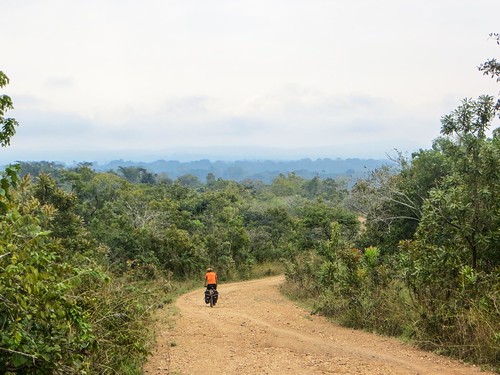
We stop at a house, at the entrance of a small village, to ask where to fetch water. The answer is not the best one, but quite common: “there is no pump in the village, we go to the stream“. However, the man gives us water from his yellow tanks.
In the meantime, I spot an orange papaya up in a tree. It is time for the food hunt!
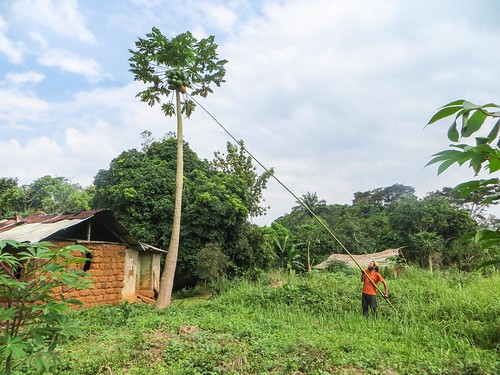
Our new friend gives us also guava, oranges, and we hunt another fruit, the corrosol. It is called savasava in the local language and soursop in English. I had never eaten it and it is delicious. The juicy white flesh with has large seeds inside like a cocoa pod.
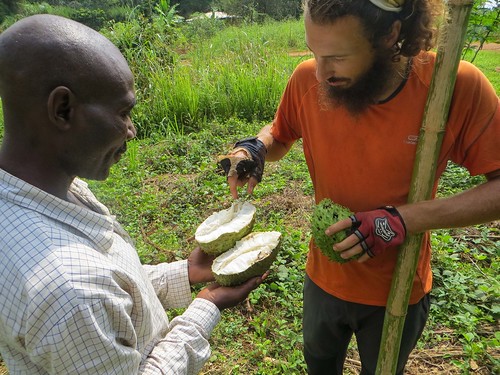
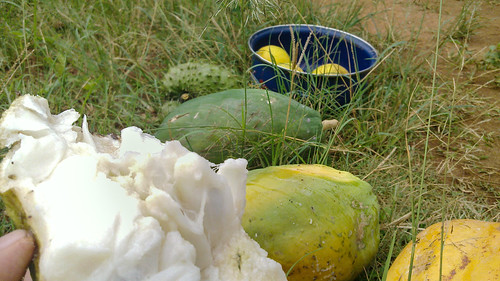
Some villagers are waiting for the only car doing the transport on this road. Else, one has to take a motorbike, it is more expensive, and also not always easy to find.
So many houses have a carpet of cocoa drying in front of them. Unlike for the bananas, the plantations are not near the road and we didn’t see any. But the fermented smell announces the presence of cocoa beans in the villages.
We stop in Manya to look for food, and there is only one option: rat and beans.
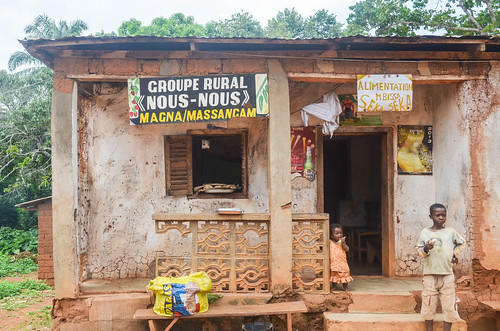

Not so long after, my tire is flat, again! I had no problems with tires and tubes during 17’000 kilometers and suddenly, I am using my 3 spare tubes in a row. It appears this time that a tiny piece of wire made its way through the Schwalbe tire. I can say this is my first puncture with the Schwalbe, and they went a lot away from the tarred roads. The current pair has “only” 9’000 km. The Schwalbe website writes they should last between 6’000 and 12’000 km. I am sure they can do more … and if this was just bad luck, they are still excellent against punctures.

With the long fruit break this morning, the lunch break and now a tube change, the bad road will never let us cycle until Bayomen where the asphalt is expecting us.

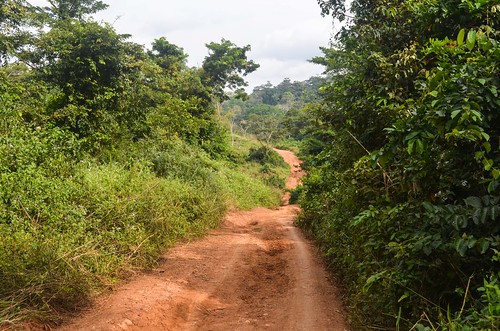
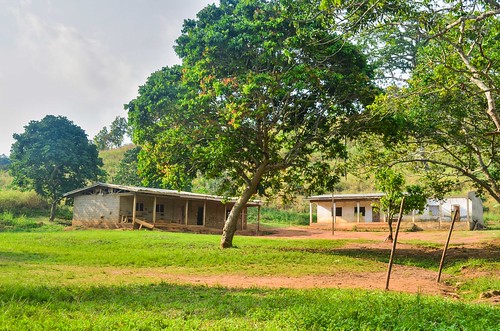
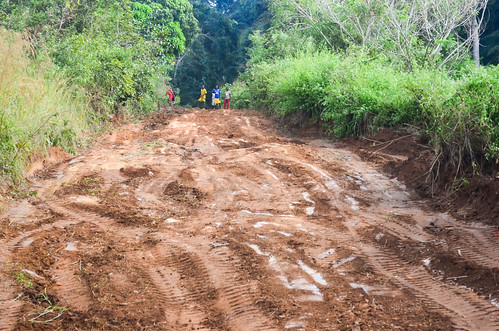

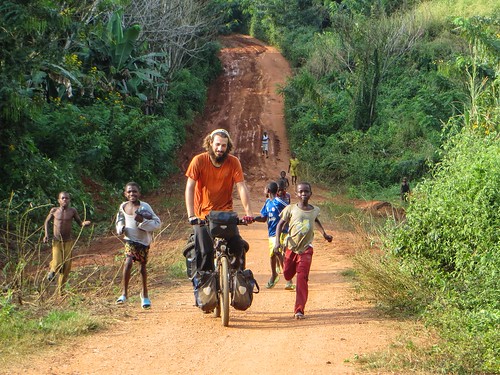
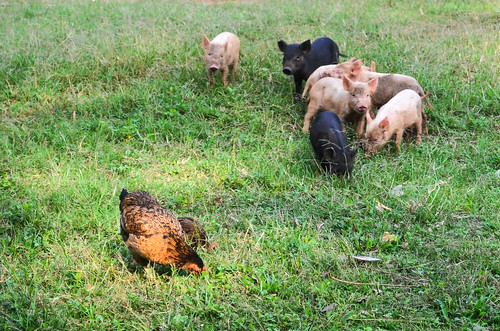
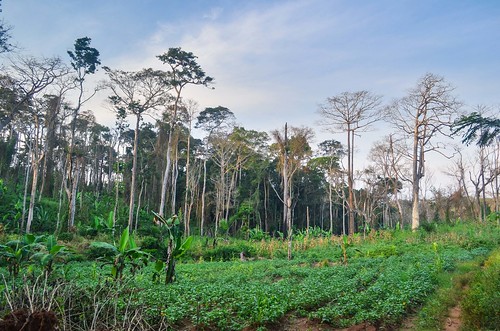
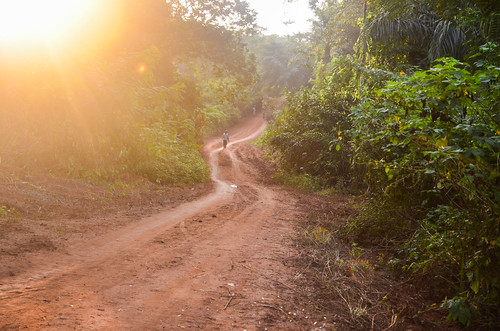
We are tricked by a small portion of tar, one or two kilometers on each side of the bridge over the Noun river. It is not yet the main tar road! But passing the Noun river marks the end of the Bamoun kingdom.
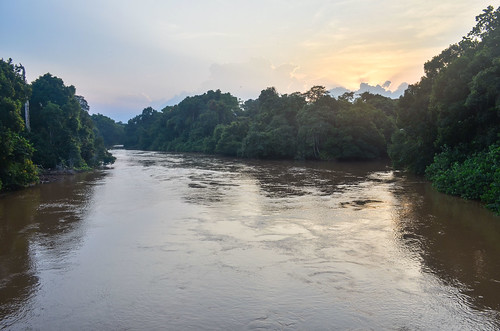
A sticky drunk man prevents us from finding an isolated camp spot, so we finally cycle until the next inhabited house and camp in the garden. We did less than 50 km today, but it was a particularly adventurous day.
“The underpants in Douala are cheaper and the new ones didn’t arrive in the bush yet” … and the long argument that followed woke me up. Our hosts are discussing prices of underpants in the bush since 6 am. When I feel a light rain hitting my tent outer sheet, I am finally kicked out my comfort to pack up quickly before everything gets too wet.
Unfortunately, at the time of leaving, my rear tire is flat again. Sigh …. I am cursed. This time, the patch is leaking air. Well, it is raining anyway, so the time loss for changing the tube is less irritating.
By the way, the rain is not doing us good: there is still a stretch of dirt road until Bayomen and the end of the ordeal. With all the punctures, the dust and the destroyed road, I am happy to leave the Bamoun.
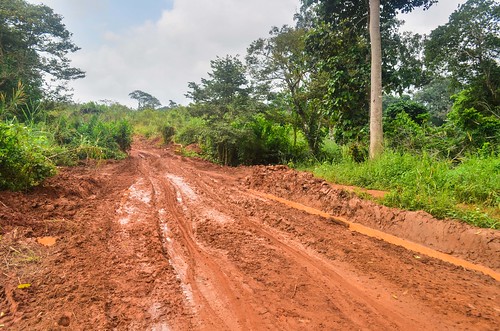
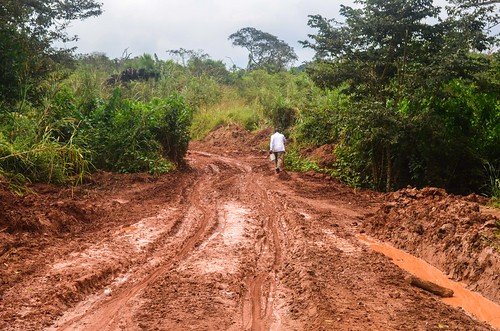
One hour and 6 kilometers later, we are back to the asphalt in Bayomen.

There is food at the crossroads, but no electricity and no water network. And very little traffic. This is surprising, we are on the main road from Yaoundé to Bafoussam and Bamenda.
The relatively big town of Bafia offers almost nothing for a 26 x 2.00 tube. After visiting many shops, I leave with an Indian one that has a strange and rusty valve. I will need to find better quality in Yaoundé. Nutritionally, we are luckier. We find 4 decent pineapples for 1000 CFA(1.5 €), eaten on the spot, and it leave just enough space for a small sandwich (and a chocolate croissant)(and 500 mL of yoghurt)(… in fact, there’s always space in a touring cyclist’s stomach).
After just 25 kilometers on the tar road, we are ready to leave it already. We dump the Bafia-Yaoundé paved road for the detour through the dirt roads of Ntui. But it shouldn’t be as bad as in the Bamoun.

Along the pleasant road to Ntui, we now see the cocoa pods by the road. There are hundred of cabosses of different colors. Orange, yellow, red … There is time for a small tasting session. The flesh around the cocoa beans is refreshing, even if it’s not the main product.
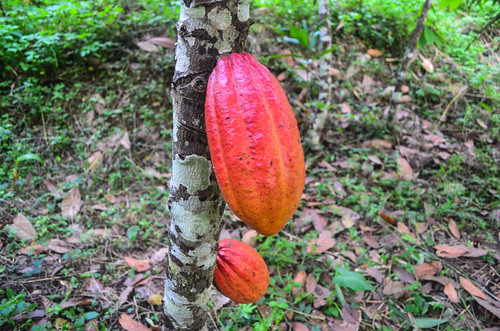
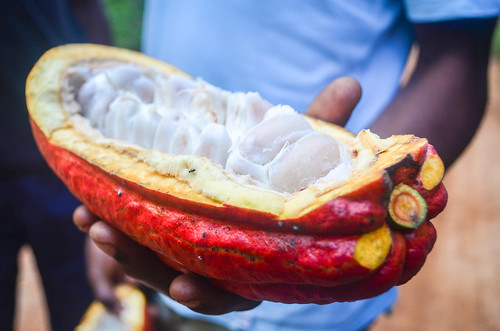
We hesitate to camp when villagers tell us there is a large town with guesthouses in 7 km. We decide to speed up and reach it just at night. Four kilometers later, we are told that Mbangassina is still in 7 km. Pfff … it happens so often to be misled this way, especially when a number is involved, but it is now getting night and every kilometer matters.
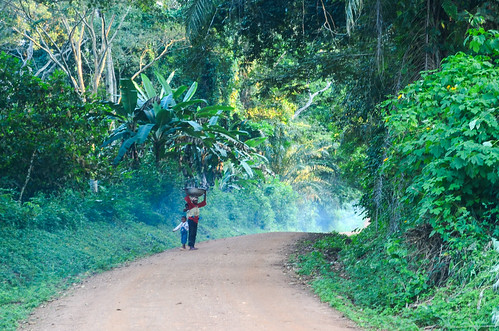
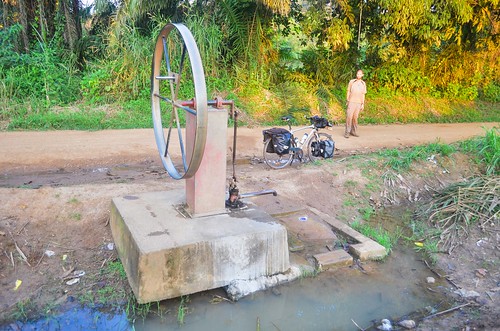
The huge and heavy wheel of the Volentas gives the pump enough inertia to pour water for a long time without touching the wheel.
We have nothing on our maps regarding this large town of Mbangassina: it only appears on the OSM map after zooming in a lot. We finally reach it after 10 kilometers of night cycling, just in time for the 7 pm prayer call.
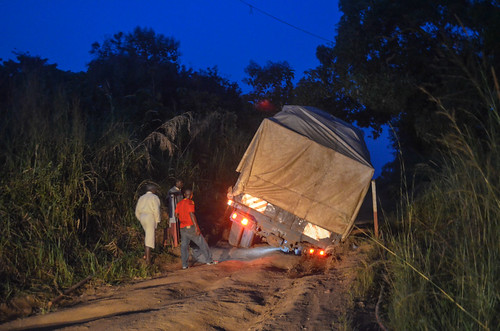

The heavy rain in the early morning makes us feel good we are not camping. Our tents were drying outside in the evening but fortunately we took them in for the night. The roads made of sand and mud will be quite an adventure today …

The road from Mbangassina to Ntui smells bad because of the fermented cocoa beans drying in front of every house of all the villages.
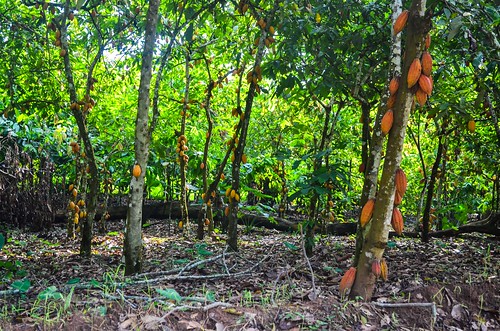

Some rivers are forming on the road. Fortunately there is more sand than mud, so it is not blocking our wheels.
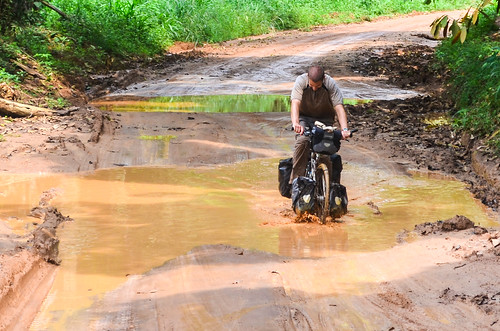

At this point I don’t know if I should write “dirt roads” and “roads”, or “roads” and “tarred roads”. Being away from the asphalt becomes normal.
There is a road to Saa via a bridge, le pont de l’espoir, but we decide to postpone our come-back onto the asphalt by taking the left road, leading to a longer piste with a river. The ferry is broken but we are confirmed that there are smaller boats (pirogues and chaloupes) operating. This detour will allow us to see the Nachtigal falls over the Sanaga river.
And the road gets even more challenging. There is one truck stuck in the mud. It is not high enough and the bottom of it hits the ground when the tires go deep into the ruts. There are more flooded sections and more large trucks carrying logs.
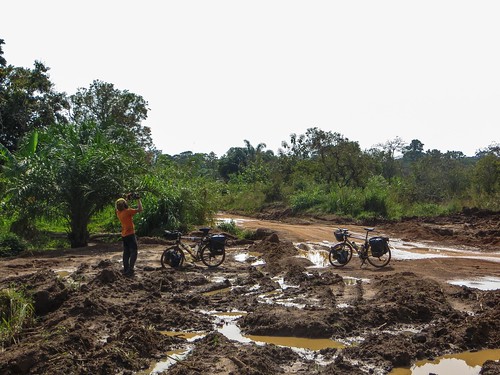
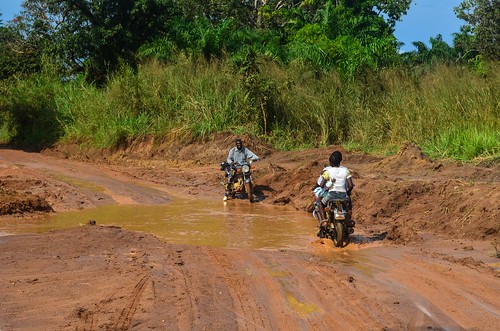
We pass through Ntui and reach the Sanaga river in the evening. Some sections of the road are awful, with a very hard corrugated iron surface, making us feel like we are purposely trying to destroy our bicycles.

The transportation system across the river is confusing and we’d rather sleep in the Nachtigal village, just before the Sanaga river. Nachtigal comes from the German explorer Gustav Nachtigal who gave his name to the village and the falls. There, we are asked to seek refuge at the chief’s house, who welcomes us for dinner and for the night. Unlike many other places, we feel there is more of moral obligation than hospitality in our interaction.
So that we can shower, we walk at night to the wheel pump at the center of the village to fill up the large yellow tanks. It is heavy and the obvious way to carry them is on the head, like everyone else. It works painfully and it will leave me a stiff neck for days.
The Nachtigal falls are very disappointing. The river is large and they are almost inaccessible. We try on land, from the Batchenga side, and it is a lot of struggle in the jungle for a little reward.
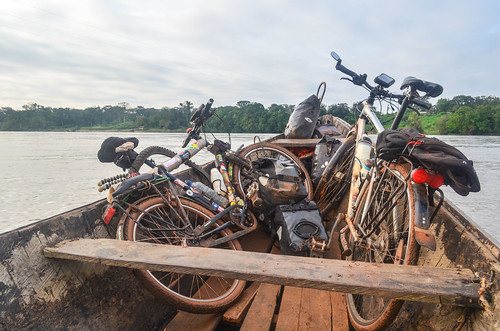
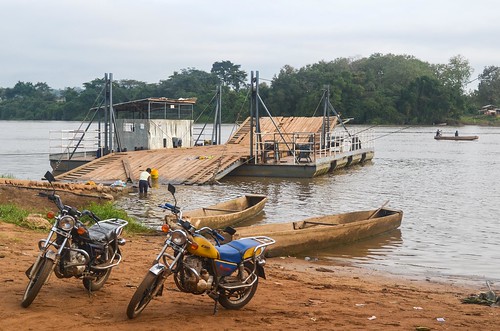
The ferry is not broken at all. It just has an engine problem. But it has been one year that the road is cut because of it. Since cars can make a detour to the bridge in Saa and motorbikes can be loaded on the boats, there is not enough motivation to make it operational again. And as in many cases, sadly, this situation can last for years …
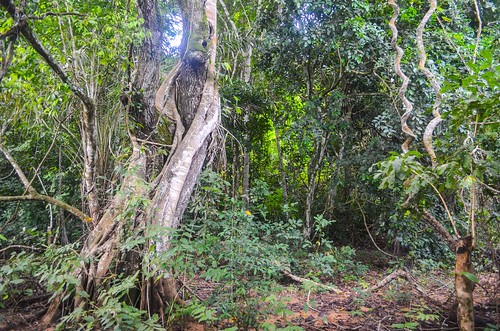
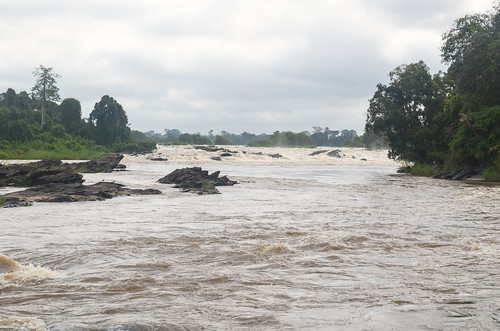
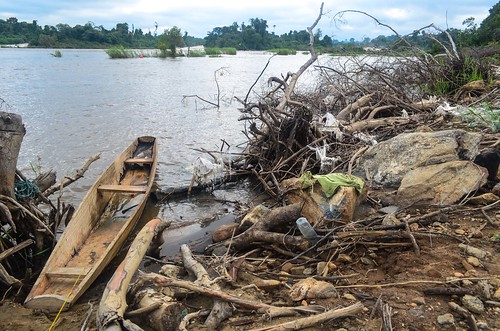
More interesting than the falls actually, are the young men digging up sand. There is a sand quarry. They work from their dugout canoes with perforated plastic buckets, serving as colanders. They take the sand from the river and pour it in the canoes.
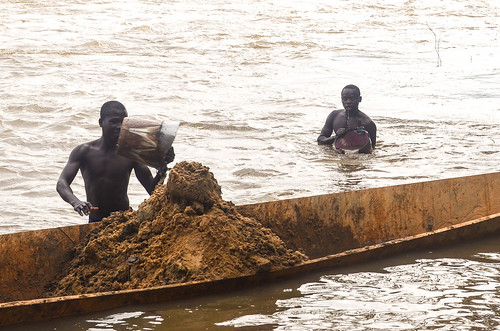
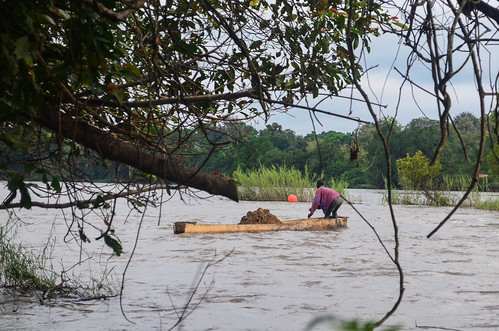
We join the asphalt in Batchenga where we eat porcupine meat. It is delicious, especially the skin.

Once on the nice road, it naturally goes much faster. In the last 370 km, since Jakiri, we cycled no more than 30 km on a tarred road. The traffic grows bigger as we get close to Yaoundé but it is rather fluid compared to what I experienced in previous capital cities.
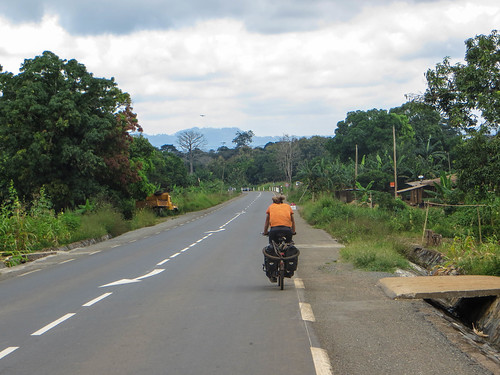

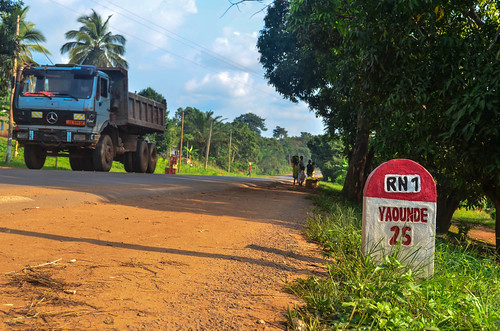
People have been shouting at us “wat! wat!” … wat what? I realized after a while it is the way francophones say “White”. So we are “le wat” instead of “le blanc”.
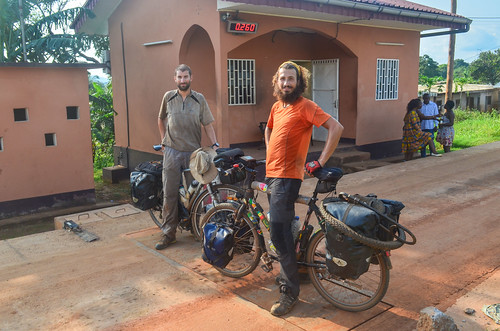
We meet also a group of policemen desperate to make pictures with us and to get a copy of them. While the drunkest is getting very annoying, the other ones can hardly make the cars stop. The drivers are simply not stopping to the whistle and the hand signs. And the policemen don’t seem to care much: they will just stop the first car who agrees to stop (and probably ask for the money of a beer). Road blocks and all those “for your security” measures are really useless …

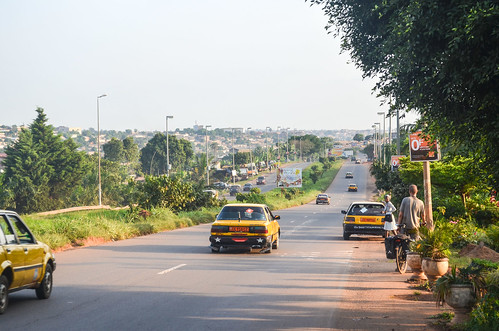
We finally reach Yaoundé, the political capital of Cameroon and second largest city, with enough time to spot the embassies of Gabon and Congo in the north of the city. We will spend the next days shopping for visas, resting, and looking for spare tubes.
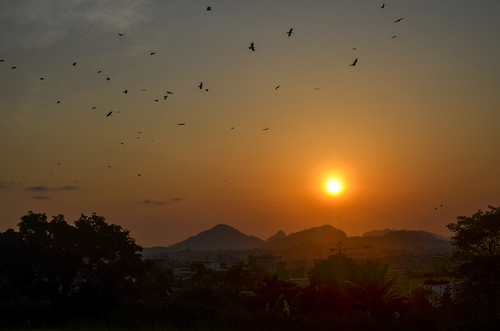





How did you travel in cameroon when you applied for the gabon visa? I mean you have to give the passport to the gabon embassy,right?
Indeed. I just stayed for 3 days in Yaoundé, with a photocopy of my passport in case someone would ask me for it.
Vous êtes géniaux!!! le mot est même petit!! Merci mille fois pour ces belles tofs!!! vous êtes passés devant chez moi à n’koovos2 près du péage de abiete et vous m’avez fais revivre ce que j’ai de plus chère au monde!! Merci encore et que Dieu vous guide et vous garde!! bon vent les gars!!